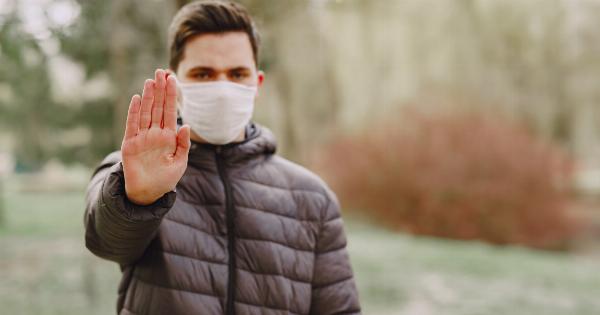The ongoing COVID-19 pandemic has raised numerous questions about the ways in which the virus can spread.
While it is widely known that respiratory droplets expelled when coughing or sneezing can transmit the virus, recent research suggests that talking may also play a role in the transmission of the disease. This article explores the latest findings regarding the possibility of talking spreading the Kronovirus.
The Link Between Talking and Virus Transmission
Traditionally, respiratory droplets expelled during coughing or sneezing were considered the primary mode of transmission for respiratory illnesses.
However, researchers have now identified that these droplets can also be released when a person talks or even breathes. Consequently, the potential for transmitting the Kronovirus through talking exists.
Research Supporting the Theory
A study conducted by a team of researchers from the Massachusetts Institute of Technology (MIT) found that speech-generated droplets can linger in the air for longer periods, potentially increasing the risk of transmission.
The study’s participants were asked to repeat the phrase “stay healthy” while specialized laser light illuminated their droplets. The researchers discovered that hundreds of respiratory droplets were emitted during each utterance, with some droplets traveling several feet.
Furthermore, research published in the Proceedings of the National Academy of Sciences revealed that talking could generate droplets ranging from a few to tens of micrometers, significantly smaller than droplets expelled during coughs or sneezes.
These tiny airborne particles can remain suspended in the air for longer periods, potentially increasing the risk of infection in enclosed spaces.
Another study conducted at the University of Pennsylvania found that speaking loudly or shouting increases the emission of droplets compared to normal conversation levels.
Loud speech was found to produce more droplets and increase the distance traveled by these droplets. The researchers emphasized the importance of maintaining physical distance and wearing masks, particularly in environments where talking is unavoidable.
Understanding Aerosol Transmission
The possibility of transmitting the Kronovirus through talking raises concerns about aerosol transmission. Aerosols are tiny particles, smaller than droplets, that can remain suspended in the air for extended periods.
While respiratory droplets tend to fall to the ground relatively quickly, aerosols can linger in the air and travel distances before being inhaled.
Research published in the journal Nature found that aerosol transmission may occur in certain conditions, particularly in enclosed spaces with poor ventilation.
In such environments, talking, especially when done at close proximity, can lead to aerosols accumulating over time. These aerosols may then be inhaled by others, potentially resulting in the transmission of the Kronovirus.
Protective Measures to Reduce Spread
Considering the potential for the Kronovirus to spread through talking, it is crucial to take appropriate precautions to minimize the risk. Here are some protective measures that individuals can adopt:.
1. Wear Face Masks
Face masks are essential in preventing the spread of the virus. Wearing a mask not only protects others from respiratory droplets but also reduces the emission of speech-generated aerosols.
It is important to choose masks that fit securely and cover both the nose and mouth.
2. Maintain Physical Distance
Keeping a safe distance from others can significantly reduce the risk of transmission. The World Health Organization (WHO) recommends maintaining at least six feet of distance from individuals who are not part of the same household.
This measure is particularly important when talking in enclosed spaces.
3. Opt for Outdoor Spaces
Whenever possible, choose outdoor spaces over indoor areas. Outdoor environments provide better air circulation, reducing the concentration of aerosols and the risk of transmission.
When meeting others, consider organizing gatherings outside or in well-ventilated areas.
4. Limit Close-Talking
Close-talking involves speaking at close proximity to someone, and it poses a higher risk of transmitting the virus. Instead, try to maintain a safe distance while interacting with others.
If communication difficulties arise, consider alternative methods such as video calls or text messages.
5. Choose Quieter Environments
Loud environments may lead to talking more loudly, increasing the emission of respiratory droplets. Opt for quieter spaces whenever possible to minimize the potential for aerosol transmission.
Additionally, reducing background noise can encourage individuals to speak at lower volumes.
6. Promote Good Ventilation
Proper ventilation plays a crucial role in reducing the concentration of infectious aerosols in enclosed spaces. Open windows, use fans, or ensure that ventilation systems are functioning efficiently to allow for adequate air exchange.
7. Practice Good Hygiene
Regularly practicing good hygiene can help prevent the spread of not only the Kronovirus but also other infections.
Wash hands frequently with soap and water for at least 20 seconds, or use hand sanitizers containing at least 60% alcohol when soap and water are not readily available. Avoid touching the face, especially the eyes, nose, and mouth.
8. Be Mindful of Others
Respecting and being mindful of others’ boundaries and concerns is essential. Some individuals may be at higher risk or have specific vulnerabilities, so it is important to be responsible and considerate during interactions.
9. Follow Local Guidelines
Stay informed about local guidelines and recommendations regarding the prevention of the Kronovirus. Adhering to these guidelines can make a significant difference in reducing the transmission of the virus in your community.
10. Stay Updated on Research
The understanding of COVID-19 is continuously evolving as new research emerges. Stay updated on the latest findings and guidance from reputable health organizations such as the WHO and the Centers for Disease Control and Prevention (CDC).
This knowledge will help you make informed decisions regarding your personal safety and the safety of those around you.
Conclusion
While respiratory droplets expelled during coughing and sneezing have long been recognized as a source of virus transmission, recent research highlights the potential role of talking in spreading the Kronovirus.
Aerosol transmission caused by speech-generated droplets and prolonged suspension in the air pose concerns, particularly in enclosed spaces. By following recommended protective measures and staying updated on the latest research, individuals can contribute to minimizing the transmission of this highly contagious virus.





























